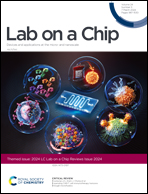Microfluidics in environmental analysis: advancements, challenges, and future prospects for rapid and efficient monitoring
Abstract
Microfluidic devices have emerged as advantageous tools for detecting environmental contaminants due to their portability, ease of use, cost-effectiveness, and rapid response capabilities. These devices have wide-ranging applications in environmental monitoring of air, water, and soil matrices, and have also been applied to agricultural monitoring. Although several previous reviews have explored microfluidic devices' utility, this paper presents an up-to-date account of the latest advancements in this field for environmental monitoring, looking back at the past five years. In this review, we discuss devices for prominent contaminants such as heavy metals, pesticides, nutrients, microorganisms, per- and polyfluoroalkyl substances (PFAS), etc. We cover numerous detection methods (electrochemical, colorimetric, fluorescent, etc.) and critically assess the current state of microfluidic devices for environmental monitoring, highlighting both their successes and limitations. Moreover, we propose potential strategies to mitigate these limitations and offer valuable insights into future research and development directions.

- This article is part of the themed collection: Lab on a Chip Review Articles 2024


 Please wait while we load your content...
Please wait while we load your content...